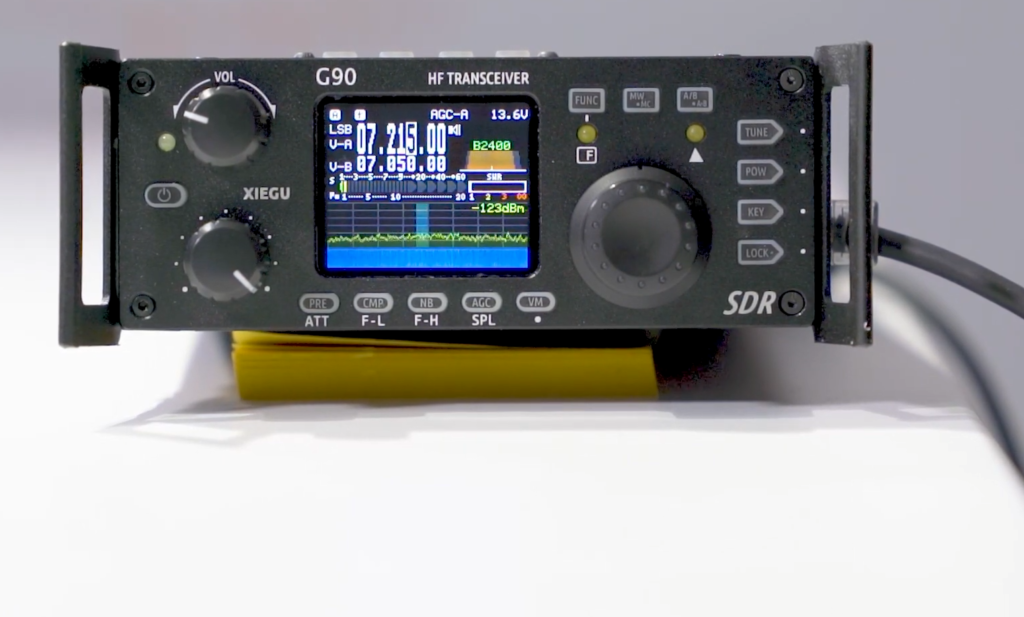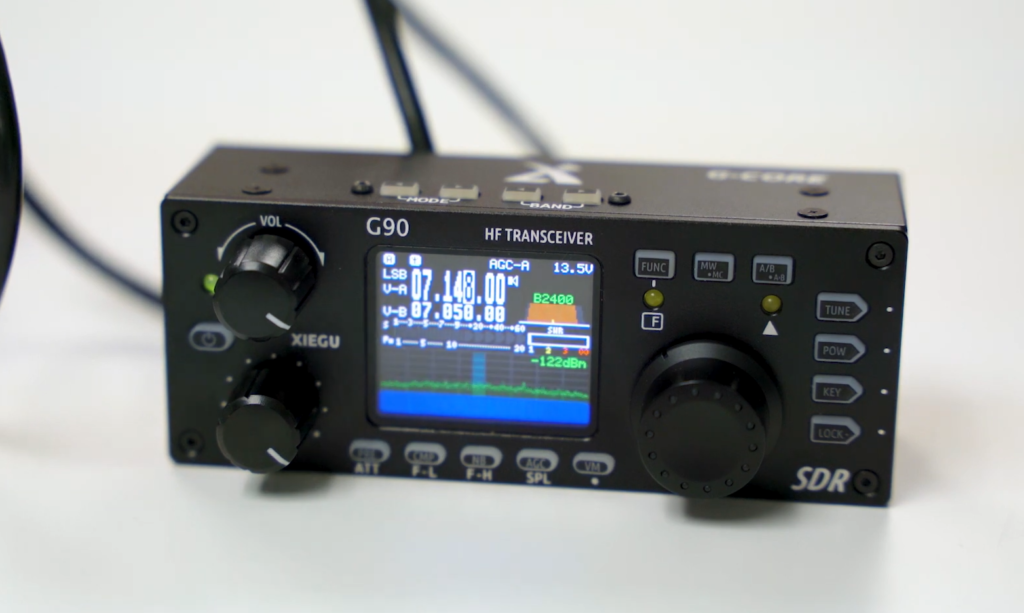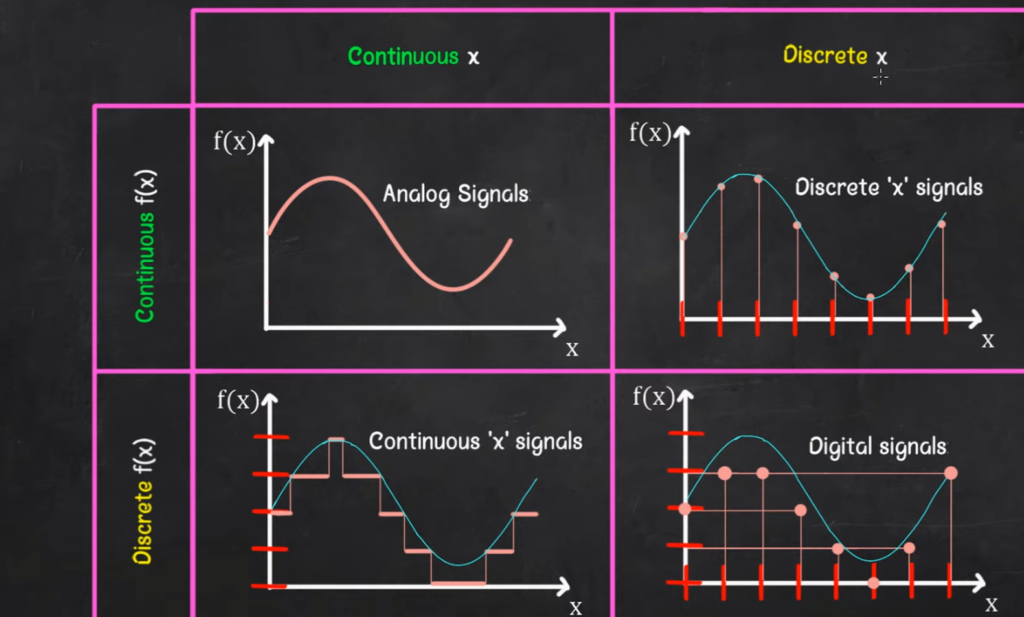Have you ever pondered the distinction between digital and analog signals? If you’re like most people, you probably haven’t given it much thought. Nevertheless, for certain disciplines like audio and video production, comprehending the distinction between these two signals is paramount.Keep reading to learn more about digital vs. analog signals and how they differ.
What is Signal?
It carries information and energy which are transmitted via these sources. Signals are used to transmit information between two or more points and can take the form of either digital signals or analog signals. [1]

What is an Analog Signal?
It is an electrical signal, such as voltage or current, which carries information from one device to another. Audio recordings and radio transmissions can be generated with the use of analog signals. In addition, many industrial and medical devices use analog signals because they are able to capture more detail than digital signals.
What is a Digital Signal?
This type of signal is generated by devices such as computers and other digital electronics, and it consists of binary digits or bits which are represented in the form of 0s and 1s. Digital signals are commonly used for transmitting data between two points, such as from your computer to an internet router or modem. Digital signals are ideal for storing complicated data, such as audio and image files, due to their use of binary numbers which can store significantly more information than analog signals. As digital signals are able to be transferred over long distances without suffering any degradation in quality, they are often preferred over analog signals for communication purposes.
Digital signals possess numerous benefits compared with analog ones, including greater precision and security. Digital signals take the cake in terms of convenience and flexibility; since they are represented by numerical values, it is much easier to manipulate them than analog signals. This makes digital signal processing much more efficient than analog signal processing. Moreover, digital signals are not only limited to telecommunications or computer networks – they can be utilized in a variety of other areas such as audio recording and video streaming. [2]

Characteristics of Analog Signals
From basic sound to intricate light, analog signals are a type of uninterrupted electrical wave used for transmitting physical data. They can be used to store and transmit information such as images and audio recordings. Analog signals are usually transmitted through copper wire cable, fiber optic cables, or airwaves (radio waves). The characteristics of an analog signal include:
- Amplitude – the height of a wave determines its amplitude; this corresponds to the loudness of a sound wave or the brightness of a lightwave.
- Frequency – Frequency is measured in hertz (Hz); it refers to how many times the wave cycles per second. Higher frequencies correspond to higher-pitched sounds and brighter lights.
- Wavelength – This is the distance between two successive identical points of a wave; it is measured in meters.
- Phase – The position of the wave relative to its starting point is called phase. This can be used to compare different signals and identify any differences between them.
Analog signals are often preferred over digital signals since they provide more accurate reproductions of sound, light, or other physical measurements. They are also easier to record with analog devices such as tape machines or turntables. However, analog signals are subject to noise and degradation over time due to interference from outside sources. Additionally, analog signals require a greater bandwidth for transmission than digital signals. This makes them less efficient for transmitting large amounts of data over long distances.
Characteristics of Digital Signals
This makes them easier to store, transmit, and manipulate compared to analog signals.
The characteristics of digital signals include:
- Sampling Rate – The rate at which the signal is sampled determines the accuracy of its reproduction; higher sampling rates provide more accurate reproductions.
- Bit Depth – The number of bits used to represent each sample determines the overall resolution or detail in the signal; higher bit depths mean more detail in the resulting sound or image.
- Encoding – Digital signals can be encoded in different ways, such as PCM (Pulse Code Modulation) or ADPCM (Adaptive Differential Pulse Code Modulation).
- Compression – Digital signals can be compressed using lossless or lossy algorithms to reduce file size.
Digital signals are often preferred over analog signals since they are more efficient and resistant to noise and degradation over time due to interference from outside sources. Additionally, digital technology allows for complex manipulation of audio and video data. However, high bit depths and sampling rates require larger storage capacities and greater bandwidths for transmission than analog signals. This makes them less suitable for real-time applications that require low latency.

Overall, there are advantages and disadvantages to both analog and digital signals. Depending on the application, one may be preferable over the other. For example, analog signals are often used to capture and record sound or images in studios due to their accurate reproductions. On the other hand, digital signals are better suited for online streaming services due to their greater efficiency and resistance to noise interference. [3]
Differences between Analog And Digital Signal
Analog signals use continuous electrical waves to represent sound, images or other data, while digital signals use discrete numbers that represent the same data.
The most obvious difference between analog and digital signals is the way they represent data. Analog signals take a physical form such as an electrical waveform, whereas digital signals are represented by numerical values within a defined range. This distinction affects the quality of transmission and reception of both types of signal depending on the application being used.
Analog representations tend to be more accurate in capturing subtle details due to their ability to replicate real-world conditions more closely than digital representations can. On the other hand, digital formats offer greater portability, bandwidth efficiency, and improved noise resistance.
Depending on the nature of the data being transmitted, analog signals may be more suitable in some cases than digital signals. For example, audio recordings require a high degree of accuracy and subtlety that can only be provided by an analog signal. However, for applications where bandwidth is limited or noise interference is likely to occur, digital signals offer superior performance.
In many modern communications systems, both types of signal are used in combination to achieve the best possible results. By taking advantage of the strengths of each type of signal, engineers and technicians can create sophisticated solutions that achieve greater levels of accuracy and reliability than either could alone.

Advantages of Analog Signals
One of the benefits of analog signals is that they are relatively easy to generate and transmit. Compared to digital signals, analog systems require fewer components to produce and operate making them more cost-effective. Additionally, analog systems inherently have a certain level of noise immunity due to their continuous nature which makes them less vulnerable to corruption from outside sources. Finally, with proper filtering techniques, it is relatively easy for an analog signal to be split into multiple streams without sacrificing data integrity.
These advantages make analog signals ideal for use in applications where cost, simplicity or signal integrity are important factors such as audio/video production or telecommunications. [4]
Advantages of Digital Signals
Digital signals offer several advantages over analog signals. One of the main advantages is that digital signals can easily be stored, accessed and transmitted across large distances without degradation. This means that digital data can remain intact no matter how far it has to travel, making it much easier to share information quickly and accurately. Additionally, digital signals are immune to interference from external sources such as noise or other electromagnetic disturbances. This makes them more reliable than analog signals which can be distorted by environmental conditions. Finally, digital signals require less bandwidth than analog signals, meaning they take up less space on your internet connection and use fewer resources when being sent across networks.
All of these benefits make digital signaling an attractive choice for communication systems and applications where accuracy and efficiency are key factors. From streaming video and audio signals to transferring files and images, digital signals offer a reliable and efficient way for data to be sent over long distances. They also provide a secure method of communication that is less susceptible to hacking or other malicious interference.
Disadvantages of Analog Signals
Analog signals also have their disadvantages. Analog signals are prone to interference from external sources such as electric and magnetic fields, which can cause signal distortion and decrease the signal quality. The cost of analog transmission is relatively higher than that of digital transmission since more transmission lines are needed for analog signals due to its relative instability and fragility compared to digital signals.
Additionally, it is difficult to store analog data for archiving or future reference unless it is converted into a digital format first.
Finally, any changes made to an analog signal require specialized equipment, making them less accessible than digital systems.
Ultimately, these factors make analog systems less efficient than their digital counterparts in many applications.

Disadvantages of Digital Signals
The main disadvantage of digital signals is that they can suffer from a phenomenon known as bit-loss. Bit-loss occurs when there is interference in the signal or it is sent through an inferior medium, such as a low-quality cable. This can result in degraded signal quality and loss of data.
Moreover, digital signals require more complex hardware than their analog counterparts, which can lead to higher costs overall.
Finally, digital signals are susceptible to latency issues due to delays along transmission paths, which can cause lag if not managed properly.
In contrast, analog signals tend to be much less prone to bit-loss and other types of distortion because they are continuous waves rather than discrete ones like digital signals. Additionally, analog systems tend to be less expensive due to their simpler hardware and easier installation process. [5]
Differences in Usage in Equipment
Digital signals are prevalent in the digital world such as computers, phones and other devices that use the Internet. These types of signals require a device to convert them into something an analog signal can understand, like a modem or router. On the other hand, analog signals are widely used for audio and visual equipment such as television sets and radios which still rely on traditional copper wires for transmission.
In addition, many medical instruments also use analog signals because they provide more accurate readings than digital ones. Furthermore, some remote control toys and robotics applications need analog signals due to their ability to read precise instructions from the remote controller.
Because of their differences in usage between digital and analog signals, it is important to choose the right type of signal based on the application. This helps ensure that the signal is received accurately and with minimal interference or distortion. It is also important to understand how digital and analog signals interact with each other, as any miscommunication between them could lead to errors in data transmission.
In a world of rapidly evolving technology, it is key to stay up-to-date on the distinctions between these two types of signals so you can make informed decisions when selecting the right type for your needs.
FAQ
What are the 3 main differences between analog and digital signals?
- An analog signal is a continuous and variable waveform that represents physical measurements, while a digital signal is composed of discrete values that represent data in binary form.
- Analog signals can be subject to noise and distortion due to electrical interference, but digital signals are more resistant because they are not susceptible to the same amount of interference.
- Analog signals require more bandwidth than digital signals for transmitting data over long distances, but digital signals have better accuracy and reliability when compared to analog signals over short distances.
What advantages does digital signal processing (DSP) provide?
Digital Signal Processing provides a number of advantages over traditional analog techniques including: greater accuracy, faster processing power, improved immunity from noise and electromagnetic interferences, more efficient data storage and transmission, improved signal-to-noise ratio, higher resolution and much more. DSP algorithms also allow for the implementation of complex algorithms which can be used to achieve a wide variety of tasks, such as improving audio quality or eliminating unwanted background noise.
What are some practical applications of digital vs. analog signals?
A number of everyday devices rely on digital versus analog signals, including televisions and radios (analog), cell phones (digital), security systems (digital) and medical equipment (analog). In addition, many industries use both types of signals in order to improve accuracy and reliability, such as automotive engineering (integrated sensors) or communications networks (voice/data transmission). Additionally, digital signal processing is used to improve the accuracy of images, videos and sound recordings. Finally, analog signals are typically used in remote sensing applications such as weather monitoring or radar systems.
What is a hybrid system?
For example, a car might have an analog engine control unit (ECU) with a digital display panel, or a security system could use an analog motion detector with a digital alarm. Hybrid systems can also be found in communications networks where both types of signals are used for voice/data transmission. Hybrid systems offer advantages over pure analog or digital solutions by taking advantage of different signal processing methods depending on the task at hand.
What challenges does using both digital and analog signals present?
Using both types of signals presents a number of challenges, such as having to synchronize the different signal formats, dealing with differences in noise levels, isolating interference between the two signal types and ensuring compatibility across various hardware. Additionally, it can be difficult to determine which signal processing techniques are best suited for specific tasks. Ultimately, hybrid systems require skilled personnel to properly configure and design them.
What is pulse-width modulation (PWM)?
This technique works by rapidly switching a digital signal on and off at regular intervals. By changing the duty cycle (the ratio of ‘on’ time to total period) the power output of the device can be varied. It is commonly used in motor control systems and other applications where precise power output control is required. In conclusion, analog signals are continuous electrical signals that are subject to distortion, while digital signals are composed of discrete values represented in binary form.
Useful Video: Analog vs Digital | Difference Between Analog and Digital Signal
Conclusion
In conclusion, digital and analog signals are two very different concepts. Digital signals are composed of binary data, meaning it uses only 0’s and 1’s for communication. This type of signal is excellent for transmitting large amounts of data in a short amount of time and can be transmitted over long distances with little to no loss of fidelity. Analog signals, on the other hand, use electrical or electromagnetic waves that represent physical phenomena such as sound or light to communicate information. These signals require more energy to transmit but they provide greater fidelity than digital signals. Ultimately, the choice between digital and analog depends on the application requirements and which type provides the most suitable performance.
References
- https://byjus.com/physics/difference-between-analog-and-digital/
- https://www.guru99.com/analog-vs-digital.html
- https://techdifferences.com/difference-between-analog-and-digital-signal.html
- https://www.softwaretestinghelp.com/analog-vs-digital-signal/
- https://www.monolithicpower.com/en/analog-vs-digital-signal














Leave a Reply